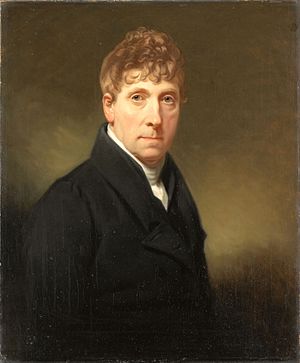Charles Howard Hodges facts for kids
Quick facts for kids
Charles Howard Hodges
|
|
|---|---|

Self-portrait, 1835
|
|
| Born | 1764 |
| Died | 24 July 1837 (aged 72–73) |
| Nationality | British |
Charles Howard Hodges (born in 1764 in Portsmouth, England, and died on July 24, 1837, in Amsterdam, Netherlands) was a very skilled British painter. He became famous for painting portraits of many important people. He lived and worked in the Netherlands during a time when France had a lot of influence there, from the late 1700s to the early 1800s.
Contents
Who Was Charles Howard Hodges?
Charles Howard Hodges started his art journey as a student of John Raphael Smith. He visited Amsterdam in 1788. After living in Dublin for two years, he moved with his family to The Hague in 1792. In 1797, he and his family moved to Amsterdam. There, he lived with his teacher, Johann Friedrich August Tischbein.
How Hodges Became a Famous Artist
In Amsterdam, Hodges became a well-known artist. He was especially good at a printing technique called mezzotint, which he learned in England. He also mastered pastel drawing, a skill he picked up from Tischbein. Hodges became very famous for his portraits. He painted over 700 portraits of important and wealthy people of his time. Besides painting, he was also an engraver, a printer, and an art dealer. He was a member of a special art club in Amsterdam called Felix Meritis.
Painting Leaders During a Busy Time
Hodges is famous for painting all the leaders of the Netherlands during the Napoleonic Wars. This was a very busy and changing time in Dutch history. The Netherlands had five different political systems during this period. Hodges painted each of their leaders. These included Willem V, who was a stadtholder (a kind of governor). He also painted Rutger Jan Schimmelpenninck, a Grand Pensionary (a top official).
Hodges also painted King Louis Bonaparte, who was the King of Holland. Later, he painted Emperor Napoleon Bonaparte himself. Finally, he painted King William I of the Netherlands. Hodges even made the only known portrait of Sebald Justinus Brugmans. He also designed an honorary cross for the Order of the Union, but King Louis Bonaparte did not approve it.
Helping to Bring Art Back Home
In 1815, Hodges gave important advice to the Dutch government. This was about getting back thousands of artworks. These artworks had been taken by the French in 1795. They were stolen from several collections, including the Gallery of Prince William V. This gallery was the first museum in the Netherlands that was open to everyone. Not all the stolen art was returned from Paris. Some pieces are still believed to be in the Louvre museum today.
Hodges' Many Artworks and Students
Most of the more than 700 portraits by Hodges were made in the early 1800s. His earlier works were often done in pastel. Later, he used oil paint. Many of his portraits can be seen in the Rijksmuseum in Amsterdam. You can also find his paintings in other museums, castles, and royal collections.
Charles Howard Hodges also taught art to others. His own children, Emma Jane Hodges and James Newman Hodges, were his students. James later became a painter who worked at the Rijksmuseum. Besides his children, Hodges taught many other artists. These included Frederik Christiaan Bierweiler, William Fleming, Lambertus Johannes Hansen, Cornelis Kruseman, Joachim Jan Oortman, Petrus Antonius Ravelli, and Francesco Tozelli.
Gallery





